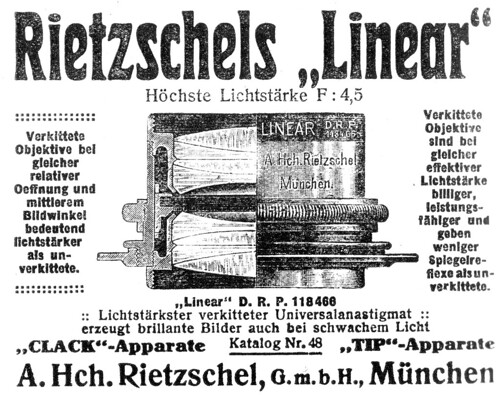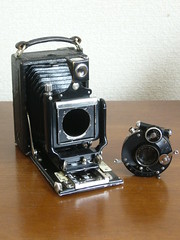Difference between revisions of "Rietzschel"
m (Corrected link) |
m (Added wikilink in camera list for Condor Luxus) |
||
| Line 25: | Line 25: | ||
* Opal | * Opal | ||
* [[Rietzschel Taschen-Clack|Taschen-Clack]] | * [[Rietzschel Taschen-Clack|Taschen-Clack]] | ||
| − | * Condor | + | * [[Rietzschel Condor Luxus|Condor Luxus]] |
* Cosmo-Clack | * Cosmo-Clack | ||
* Spezial-Clack | * Spezial-Clack | ||
Revision as of 19:37, 22 October 2011
On July 12th 1896 Alexander Heinrich Rietzschel founded the Optische Anstalt A. Hch. Rietzschel in Schwabing, a suburb of Munich. Rietzschel was an optician and precision mechanic from Dresden who had learned his professions at Carl Zeiss Jena and had worked some time for Rodenstock and Steinheil.
The company's first products were lenses. In 1900 it produced its first camera, the Clack 1900. It produced cameras for amateurs as well as studio cameras for professionals. In 1921 the company was bought by Bayer (of Leverkusen), which handed it over to the film maker Agfa in 1925, as part of the merger of both in the IG Farben conglomerate.
In 1910 the company offered a symmetrical anastigmatic lens with 8 elements in only two groups. With this arrangement there were only two groups between which reflections could appear. A similar anastigmatic lens was made by E. Suter.

|
| ad of 1910 |
Lenses
- Linear
- Prolinear[1]
Names later used by Agfa:
- Apotar
- Solinar
Cameras
- Clack 1900
- Tip
- Opal
- Taschen-Clack
- Condor Luxus
- Cosmo-Clack
- Spezial-Clack
- Ninon 604

|
| Miniature Clack 4×6.5cm with Linear f/6.3 90mm image by eBayer Yalluflex (Image rights) |

|
| Miniature Clack 4x6.5cm removable lens image by eBayer Yalluflex (Image rights) |

|
| Miniature Clack 4x6.5cm removable lens image by eBayer Yalluflex (Image rights) |
Notes
- ↑ Japanese collector 'ksmt' shows a 13.5 cm f/1.9 Prolinear, made for a Mentor 6.5×9 cm Mentor camera. It has four single glass elements, and is essentially a triplet, with the rear element split into two parts, like one version of the Taylor and Hobson Speedic lens. ksmt shows a lens diagram, and photographs of the lens dismantled, and mounted on a DSLR; also sample photographs.
| Camera industry in Munich |
| Agfa | Deckel | Eder | Enna | Friedrich | Kilfitt | Leitmeyr | Linhof | Niezoldi & Krämer | Perka | Rex | Rietzschel | Rodenstock | Staeble | Steinheil |